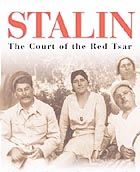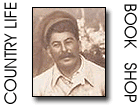Book Review: The Court of the Red Tsar
Simon Sebag-Montefiore reveals the vast network of people who kept Stalin in power during his worst excesses.


History has had it - so far - that the genocidal maniac Adolf Hitler was the past century's most vile dictator. I say 'so far' because this magnificent book by Simon Sebag Montefiore is sure to help strip some of the remaining veneer of decency from Hitler's closest rival, Joseph Stalin.
When one has read the catalogue of mass murders, arbitrary exercises of evil and sheer paranoia that were the everyday products of 'Uncle Joe's' court, it becomes astonishing that anyone could ever whitewash this monster again.
The author rushes over the first 40 or so years of Stalin's life, then deals, in meticulous detail, with every aspect of Stalin's everyday life as he seizes power in the Soviet Union and seeks, by ruthless means, to hold onto it.
There are superb pen-portraits of all the other main hate figures: Moltov, Kaganovich, Khruschev and Mikoyan. Stalin's own appalling character drives a young wife to suicide; he then proceeds to exterminate a substantial proportion of a whole nation.
Mr Montefiore takes Nadya Stalin's suicide - with a pearl-handled revolver given to her by her brother as a souvenir of a trip he had made to Berlin - as a turning point in her husband's warped life. He had not been exactly benign before it: after it he became a psychopath.
In this real-life version of George Orwell's Nineteen Eighty-four, Stalin has a police state searching for 'enemies' everywhere. He starves a whole class - the Kulaks - to death because their entrepreneurial farming was deemed a threat to collectivism. He decides that a large proportion of officialdom, fromt the Politburo downwards, are spies and wreckers. When dissatisfied by the stream of executions of those his paranoid mind thinks he can identify, he then sets quotas of executions. Innocents are inevitably killed, but a revolution without blood is, apparently, worthless.
By the time of the Second World War, this reign of terror has subdued all possible opposition to him. With his evil and sadistic secret police chief, Lavrenti Beria, doing his bidding, no one is safe. Even the wives of Politburo members are carted off to their deaths on the spurious grounds that they are 'enemies': and so terrified are their husbands that, in most cases, they simply say nothing and marry again.
Sign up for the Country Life Newsletter
Exquisite houses, the beauty of Nature, and how to get the most from your life, straight to your inbox.
Those who serve Stalin loyally are every bit as likely to end up with the executioner's pistol at their necks, after prolonged and violent torture, as those who dislike him. It was a culture of sycophancy, unreason and downright insanity, and the gossipy style in which the author presents his painstaking research brings the poisonous atmosphere home to the reader vividly.
Mr Montefiore has left nothing to chance in writing what will become an authoritative text on the life of this monster. As well as reading extensively in files opened to the public only in recent years, he has interviewed the widows and children of those who were at the Red Tsar's court.
Having also had access to unpublished memoirs, he provides a remarkably fresh and exciting account of one of history's blackest periods. This really is an astonishingly good and important book, and should serve to convince all but the most hardened communists that in the contest of the evil dictators, the result was really too close to call.Order Stalin: The Court of the Red Tsartoday
Return tobook reviews


Country Life is unlike any other magazine: the only glossy weekly on the newsstand and the only magazine that has been guest-edited by HRH The King not once, but twice. It is a celebration of modern rural life and all its diverse joys and pleasures — that was first published in Queen Victoria's Diamond Jubilee year. Our eclectic mixture of witty and informative content — from the most up-to-date property news and commentary and a coveted glimpse inside some of the UK's best houses and gardens, to gardening, the arts and interior design, written by experts in their field — still cannot be found in print or online, anywhere else.
-
 Six rural properties with space, charm and endless views, as seen in Country Life
Six rural properties with space, charm and endless views, as seen in Country LifeWe take a look at some of the best houses to come to the market via Country Life in the past week.
By Toby Keel
-
 Exploring the countryside is essential for our wellbeing, but Right to Roam is going backwards
Exploring the countryside is essential for our wellbeing, but Right to Roam is going backwardsCampaigners in England often point to Scotland as an example of how brilliantly Right to Roam works, but it's not all it's cracked up to be, says Patrick Galbraith.
By Patrick Galbraith